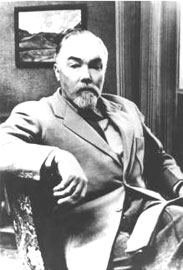IN RUSSIA
|
After the passing of his mother, George Roerich continued to live in Kalimpong. He did scientific work and taught at the Kalimpong University.
Two years later, he received permission to move to his Homeland; and in the fall of 1957, he moved to Moscow. At that time George was a world-renowned scientist and Orientalist, and a member of scientific societies in many countries of the world.
In Moscow he was the head of a department in the Institute of Oriental Studies, where almost from the onset, he revived the Soviet school of Tibetology. He wrote scientific works, gave lectures, and worked on the completion of a Tibetan-Sanskrit-Russian-English dictionary, which was voluminous. The latter was the work of his life. But the most important of his deeds was that he returned the name of the Roerichs and the Living Ethics (Agni Yoga) to Russia.
Before George Roerich’s arrival in the Soviet Union, almost nothing had been known about this great family. In political circles Nicholas Roerich had been considered an emigrant, and for many years people had remained purposely silent about him. Only a few people had heard that somewhere in India there lived such a Russian painter. George brought with him and gave to Russia 418 paintings of his father.
Seven months after George’s arrival in Moscow, the first exhibition took place, which he had exerted a great deal of effort to organize. Subsequent exhibitions were shown in Leningrad (St. Petersburg), Riga, Kiev, Tbilisi and other cities.
George Roerich presented many lectures about his father, his painting, his literary works and his world outlook. There was great interest at the exhibitions, which were attended by thousands of people. Gradually, people’s interest in the artist’s personality naturally shifted to his philosophy and the Living Ethics. Since the books of the Teaching were still prohibited, one had to find them and make copies using various methods — most copies were made from those published in the ’30s in Riga (Latvia). The older generation of Roerich followers preserved them at great danger to themselves.
It wasn’t easy for George Roerich to be in Moscow. He had to live and work under the intense scrutiny of the ideological services, in the atmosphere of ignorance, suspicion, and often hostility from various officials and administrators. He constantly had to overcome various obstacles, which loomed one after another. On the other hand, ordinary Russian people treated him with love and warmth, and reached out to him as a source of Light and Knowledge.
On May 11, 1960, a personal exhibition of Svetoslav Roerich paintings opened in Moscow. The huge work of organizing it had been done by George Roerich. For the opening of the exhibition, Svetoslav and Devika Rani-Roerich came to Moscow. When the exhibition was in full swing, there were meetings that took place and conversations with friends, who had arrived from different cities. Often the meetings were held in George Roerich’s apartment.
Then suddenly and very unexpectedly, on the 20th of May, he felt bad and within several hours passed away. He left this world at the age of fifty-seven, in the prime of his creative life. The prophecy of Helena Roerich had come true — he had stayed in Russia for almost three years. And not in vain exactly at that time his brother arrived in Russia.
George Roerich, not long before his passing from this world, had said that the pre-ordained Task set before him concerning his Homeland had been entirely fulfilled.

